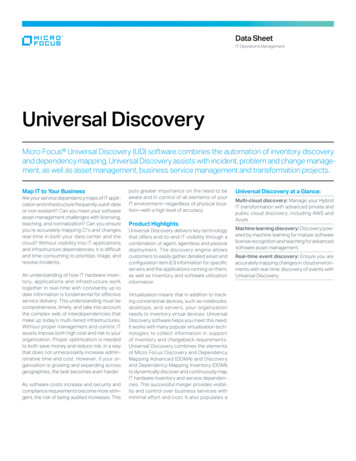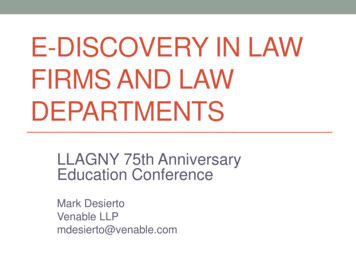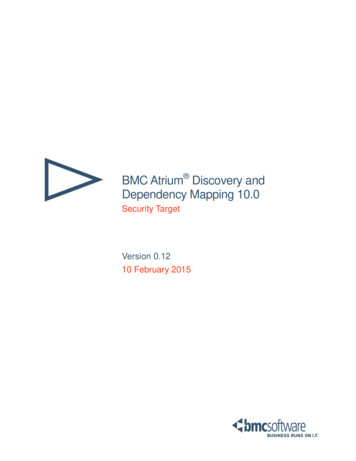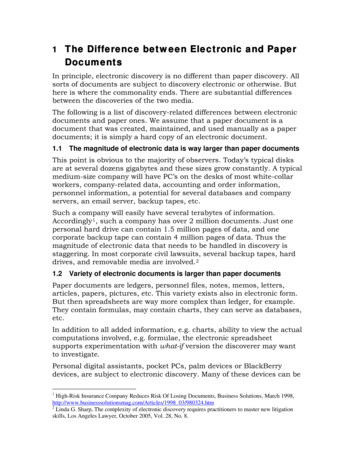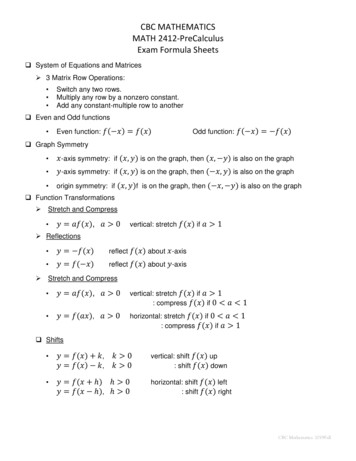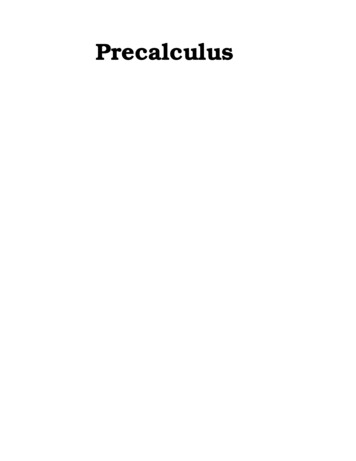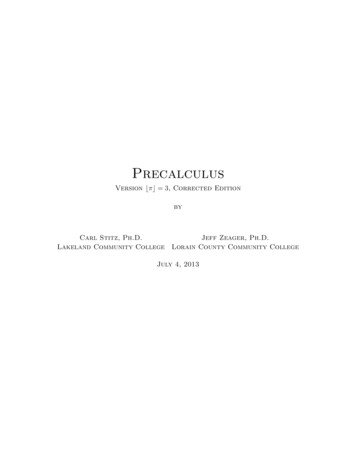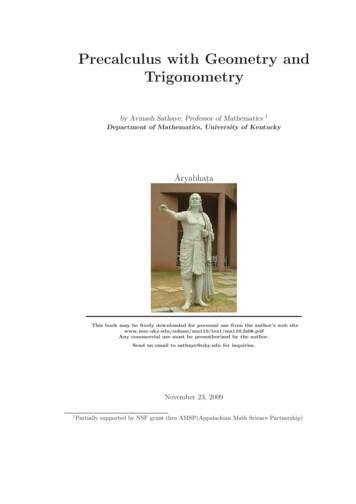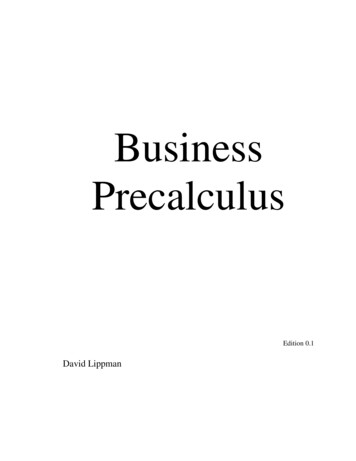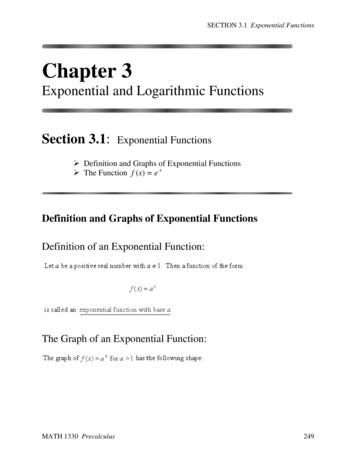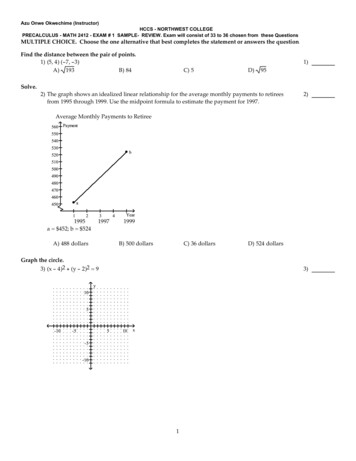
Transcription
Discovery Precalculus:A Creative and Connected ApproachLead Authors: Mark Daniels and Efraim P. ArmendarizOther Contributors: Hanna Bennett, Amanda Hager, Anna Spice, Brandy Guntel, George Innis,Lesley Johnson, Brian Katz, Emily Landes, Bill Russell, Heather Van Ligten, Jeremiah Lucas, andDaniel GerdsVersion: 4 c@2019University of Texas at Austin
In memory of Ted Odell, Professor of Mathematics at the University of Texas at Austin, whose efforts helped launch thisproject. Also, in memory of Professor of Mathematics Efraim Armedariz, whose ideas and creativity inspired some ofthe explorations in this text.
Discovery Precalculus: A Creative and Connected ApproachContentsPREFACE 6INTRODUCTION 7UNIT 0 Lesson 0.1: Getting Started – Thinking Like a Mathematician UNIT 1 8811Lesson 1.1: What is a Function? 11Lesson 1.2: Functions and Types of Functions 15Lesson 1.3: A Qualitative Look at Rates 28Lesson 1.4: Sequences and Triangular Differences 32Lesson 1.5: Functions Defined by Patterns 34UNIT 2 41Lesson 2.1: Algebra and Geometry 41Lesson 2.2: Complex Geometry and Roots 44Lesson 2.3: Conic Sections 47Lesson 2.4: Using Matrices to Find Models 54Lesson 2.5: Using Statistical Regression to Fit a Function to Bivariate Data 58UNIT 3 64Lesson 3.0: Exponent Properties 64Lesson 3.1: A Special Number 68Lesson 3.2: The Natural Logarithm Function as the Inverse of ex 713
Discovery Precalculus: A Creative and Connected ApproachLesson 3.3: Growth and Decay 75Lesson 3.4: Using Functions Defined by Patterns in Application 78UNIT 4 79Lesson 4.1: Working With Identities 81Lesson 4.2: Trigonometric Foundations 82Lesson 4.3: The Trigonometric Functions Off the Unit Circle 86Lesson 4.4: Angular and Linear Speed 96Lesson 4.5: Back to Identities 98Lesson 4.6: The Roller Coaster 104UNIT 5 107Lesson 5.1: First, Some Background — Rational Functions 107Lesson 5.2: Limits 112Lesson 5.3: Approximating Rates of Change 116Lesson 5.4: The Derivative 121UNIT 6 126Lesson 6.1: A Nonstandard Exploration of the Rate of Change of Functions 126Lesson 6.3: Applications of Parametric Equations 131Lesson 6.4: Vectors 133Lesson 6.5: The Golf Shot 141Lesson 6.6: The Polar Coordinate System 143Lesson 6.7: A Nonstandard Exploration of the Polar Coordinate System 146Lesson 6.8: Classic Polar Relations 153Lesson 6.9: Complex Numbers 1574
Discovery Precalculus: A Creative and Connected ApproachUNIT 7 161Lesson 7.1: Arithmetic and Geometric Sequences 162Lesson 7.2: Convergent Sequences 165Lesson 7.3: Series and Partial Sums 166Lesson 7.4: Convergent Geometric Series 168Lesson 7.5: Induction 171Lesson 7.6: Probability and Combinatorics - a Momentary Diversion 172Lesson 7.7: The Binomial Theorem175 5
Discovery Precalculus: A Creative and Connected ApproachPREFACEDiscovery Precalculus: A Creative and Connected ApproachTo the StudentIt is my genuine hope that the student/learner experiences this text in an exploratory andcollaborative manner. The presentation of topics in this text is done in an inquiry-basedformat so as to invite the learner to actively participate in the Lessons that develop the material of this innovative Precalculus course. The topics covered in this text encourage students to recall previous knowledge, analyze the current Exploration, and then synthesizeprior knowledge and new concepts. The Precalculus concepts in this course are introducedin such a way as to emphasize the connections between these topics at a university levelof thinking. I believe that the material and mathematical connections made in this text areessential to preparing students to be creative and independent thinkers who are preparedfor success in various future paths.Based on future degree and career choices, some students/learners may need to understand the mathematical concepts in this text in more depth than others. The reason for theexploratory and collaborative nature of this mathematics text is to engage all students inthe synthesis of content to deepen critical thinking skills; this is why you may notice less ofa focus on a particular topic and more emphasis placed on the merging of prior and newknowledge.This course is meant to deepen students’ mathematical content knowledge, but also meantto foster creativity, collaboration, communication, and persistence. As students workthrough the Explorations in this text, they will interact with their peers and their instructorat a level they may not have previously experienced in a mathematics course. If the studentcompletes this course with better critical thinking skills, communication skills, and an appreciation for productive inquiry, then the student is empowered for success in any futurepath chosen.Sincerely,The Author6
Discovery Precalculus: A Creative and Connected ApproachINTRODUCTIONDiscovery Precalculus: A Creative and Connected ApproachThe layout of this text is presented in sections labeled by “Lesson” of instruction. TheseLessons are of varied length, some of which can be covered in less than one class periodand others may take multiple class periods to complete. It may be the case that you don’tuse all of the Explorations within, or that you don’t finish all of the Explorations within eachLesson. Always keep in mind that the implementation of this course should not be donewith the mindset of “racing to the end of the book.”The key to experiencing this course appropriately is to approach the associated teaching and learning with a flexible mindset. Let the Explorations take you in many directionsbased upon the presentation and discussion of the material under investigation. Consider and be open to the fact that there are often multiple ways to approach or obtain thedesired result for a given Exploration. Much of the learning in this course will come fromlistening to others’ justifications and explanations of how a result was obtained.Let us begin!7
Discovery Precalculus: A Creative and Connected ApproachUNIT 0Essential Pre-Requisite UnitLesson 0.1: Getting Started – Thinking Like a MathematicianThe three Explorations of this section are meant to “get you started” on the right track regarding the expectations of this text. These three Explorations of Lesson 0.1 are designedto be accessible to you no matter what your mathematics background is at this point.This text is meant to accompany a mathematics course that, among other things, is about“thinking.” Starting with Lesson 1.1, it is our intention that the activities presented withinwill entice you to think deeply about the mathematics of precalculus, about new ideas presented, and about the connections between the two. With this in mind, let’s get started.Exploration 0.1.1: A Common Cube ConundrumSuppose one desired to move along the surface of the cube from the top far corner(point A) to the near bottom corner (point B). Would the dark line path marked inthe picture be the shortest route from point A to point B? If you agree, justify youranswer. If you do not agree, describe the shortest path and justify your answer. Isthe shortest path solution that you have chosen unique?8
Discovery Precalculus: A Creative and Connected ApproachExploration 0.1.2: The Efficient WaterlineThe city wishes to connect two houses to an existing water supply line using a singlepump at the supply line and a minimal amount of pipe extended to each house. Thehouses are located at different distances from the street (as pictured). In theinterval from C to D, where should the pump connection be located on the supplyline? Of course, you must justify your answer. Assume C and D are located directlybeneath the connection point on houses A and B respectively.As mentioned previously, it is important that you also make connections betweenmathematics concepts you are asked to remember and that you newly learn in this course.The next Exploration is a good example of making connections between topics andconcepts in mathematics.9
Discovery Precalculus: A Creative and Connected ApproachExploration 0.1.3: Making ConnectionsGiven the three topics listed below, devise a visual, verbal, and algebraic way of connecting the concepts:1. The distance formula2. The standard equation of a circle (not centered at the origin)3. The Pythagorean TheoremThis Exploration is a good precursor for the topic of trigonometry based on trianglerelationships on the Unit Circle. You will learn about this in a later Unit of the text.10
Discovery Precalculus: A Creative and Connected ApproachUNIT 1Functions, Rates, and PatternsLesson 1.1: What is a Function?In this section, we will take a deeper look at the concept of function in terms of a function’sdefinition, type, and general properties. You have encountered and worked with functionsin your mathematical experiences so far, but have you really thought much about whatconstitutes a function?Exploration 1.1.1: Function?Work in groups to answer the question, “What is your definition of a function?” Eachgroup should agree upon and present one definition.Each group should also display their agreed-upon definition for the class and alldefinitions should be recorded by each student. At this point, however, a formaldefinition of function should not yet be formulated.Exploration 1.1.2: Function IdentificationDecide, in groups, which of the relations listed below are examples of functions;justify your answers.Function?1Justificationy –x²11
Discovery Precalculus: A Creative and Connected 4(5, 6)3(3, 2)(5, 1)412
Discovery Precalculus: A Creative and Connected ApproachFunction?JustificationAlso identify: What does thegraph of this relation look like?5y4 8x26Tom: BlueJill: Brown7Bill: GreenHarry: Green13
Discovery Precalculus: A Creative and Connected ApproachExploration 1.1.3: Function IdentificationAs you discuss these problems, consider the meaning of the symbols in the setbuilder notation. These symbols should be discussed in class as part of the nextsection.1. Let Ato B?a, b, c , B2. Let A 1, 2, 3 , BA to B?4, 5, 6 }, and f{ c, d, e } , and g(a, 6), (b, 4), (c, 6). Is f a function from A(1, d), (2, c), (1, e) }. Is g a function from3. Let M be the set of all museums and N the set of all countries.Consider the set of all ordered pairs (m, n) such that museum m is in country n.This can be written symbolically asL {(m, n) M x N the museum m is in the country n}.Is L a function from M to N?4. Let D be the set of all dogs, and letC {(d, o) D x D the dog d is a parent of the offspring o}.Is C a function from D to D ?Take-home exerciseReflect on your informal work in trying to describe what a function is and considerthe various group definitions of function presented. Now revise the definition youoriginally created for describing a function in order to develop a more refined definition. Explain your reasons for refining (or not refining) your definition.14
Discovery Precalculus: A Creative and Connected ApproachLesson 1.2: Functions and Types of FunctionsWe will now attempt to formalize our definition of function by providing three textbookdefinitions of the concept of function. Note the use of the symbols in each definition. Asyou read over the three provided definitions of a function, you are asked to consider thecommonality and differences between these definitions and the one that you have previously written. Three examples of how a function might be defined are:DEFINITION Given two sets A and B, the set A B, the Cartesian product of A and B, denoted A x B, is the set of all ordered pairs (a, b) where a A and b B. A subset of A B iscalled a relation. Thus:1. A function from A to B is a pairing of elements in A with elements in B in such a waythat each element in A is paired with exactly one element in B.2. A function f from A to B is a rule or relation between A and B that assigns each elementa A to a unique element b B.3. A function f from A to B is a subset of the Cartesian productA B(a, b) a A, b Bsuch that b is unique for each aA.EXERCISE: Why is it or is it not important to have a precise definition of the termfunction? Also, which of the supplied function definitions do you like best, and why?15
Discovery Precalculus: A Creative and Connected ApproachDEFINITION: If we have a function and it is viewed as a subset of the Cartesian crossproduct A B, then the set of all elements of A that appear will be called the domain of thefunction. The set of all elements of B that appear will be called the range of the function.DEFINITION: If we have a function and it is viewed as a subset of the Cartesian crossproduct A B, then the set B is called the codomain of the function.DEFINITION: Given a function rule y f (x), in the event that a domain is notspecified, the domain is taken to be the natural domain or implied domain, which is the setof all real numbers to which it is possible to apply f.Exploration 1.2.1: Function FoundationsDomain and Range1. Can the size of the domain be smaller than the size of the range?2. Can the size of the range be smaller than the size of the domain?3. What happens if the domain and range have the same number of elements?What if both the domain and range have infinitely many elements?Are These Two Functions Equal?For each of these pairs of functions, decide if and why the functions are identical. Ifthey are not identical, what do they have in common?4.(1, 3), (2, 3), (4, 4)5. The functions f (x)and(1, 3), (2, 4), (4, 4).x 3 with domain 1, 3 and f (x) x 3 with domain 2, 3 .6. The functions y x 2 with domain all real numbers and y x 2 with domain all realnumbers except the number 1. (You can do this one using graphs to supportyour reasoning, if you would like.)7. The functions y x 3 6x 2 8.5x and y160.5x with domain 0, 2, 4 .
Discovery Precalculus: A Creative and Connected ApproachNatural/Implied Domain8. What is the natural domain of f ( x ) g( x) x 2 ?9. What is the natural domain of1?x ? What is the natural domain of1x ? What is the natural domain of10. Can you make a generalization or set of rules to help compute the naturaldomain of a function?f (x) is defined on an interval a, b , then f (x) is increasingon a, b , if, whenever x 1 x 2, then f (x 1) f (x 2). The function f (x) is decreasing on a, b , if,whenever x 1 x 2, then f (x 1) f (x 2).DEFINITION: If a function yExploration 1.2.2: Function Increase and DecreaseConsider the definition above and the graph of y(x 1)(x 2)(x 3).1. Is this graph increasing on 3, 4 ?2. Is this graph increasing on 2, 4 ?3. Do you think it should make sense to say “This graph is increasing at x 3?”If no, why not? If so, how can we create a definition of what it means for afunction to be increasing at a single number instead of an interval?17
Discovery Precalculus: A Creative and Connected Approach4. Draw a function y f (x) with the following properties:,3 The domain is The range is f (0) 1 The x intercepts are at 1 and 11, )Historical Notes1. Although the notion of a function dates back to the seventeenth century, a relationbased definition, as we use today, was not formulated until the beginning of the twentieth century. The concept of mathematical relations first appears in a text by RenéDescartes in 1637 named Geometry, and the term “function” was introduced about fiftyyears later by Gottfried Wilhelm Leibniz. It was Leonhard Euler, in the eighteenth century, who first used today’s notation y f (x). Finally, it was Hardy who defined, in 1908,a function as a relation between two variables x and y such that “to some values of x atany rate correspond values of y.”2. French author Nicolas Bourbáki, is not a single author but a group of authors whocame together in the late 1950’s in an effort to standardize the language of modernmathematics. That language is used in the definitions that follow. Among the groupwas mathematician John Tate, who later became a faculty member at the University ofTexas at Austin.Function TypesIn addition to knowing whether one is working with a function or not, it is often useful toknow the type of function under investigation based upon the mapping properties of thefunction.Given two sets A and B,DEFINITION A function f : Aif B range f.B is called surjective (or is said to map A onto B)DEFINITION A function f : A B is called injective (or one-to-one) if, for all aand a in A, f (a) f (a ) implies that a a .DEFINITION A function f : AB is called bijective if it is both surjective and injective.18
Discovery Precalculus: A Creative and Connected ApproachExploration 1.2.3: Types of Functions1. Devise and explain two examples each of a surjective function that is not injective, an injective function that is not surjective, and a bijective function.2. Characterize the function f pictured here:3.An odd function is defined as a function that meets this criteria:f ( x ) f ( x ) ,and an even function is defined as one that meets the criteria:f ( x ) f ( x ) .Of course functions can be neither even nor odd. List at least 10 different functionsyou have studied in the past, and then state and justify whether each function iseven, odd, or neither.4. Sketch graphs of the parent functions for the list you just created. What conjectures can you make about the symmetries of each function and that function'sclassification as even, odd, or neither? Consider symmetry about the x-axis, yaxis, and the origin.5. Is it possible for a function to be both even and odd? Justify your reasoning.19
Discovery Precalculus: A Creative and Connected ApproachComposition of FunctionsThe composition of functions involves taking the output values from one function and usingthose as the input values for a second function. Visually, it looks like this:Using a more general approach, the composition of functions can be thought of as a situation where one or more functions are nested inside another. An example of this would be.(1)x with the functionWe think of this function as being composed of the function3g ( x ) x 2 nested inside of it. Thus, (1) can be thought of as h (x) f (g (x)) which canalso be written as h (x) ( f g) (x) and stated “h of x is equal to f in composition with g.”Exploration 1.2.4: Composite Functions1. Using the same f and g functions described in the previous paragraph, write thefunction that is "g in composition with f." This new function could be symbolizedby g ( f (x)) or (g f ) (x).2. In general, is it true that f (g (x))of the composition of functions.g ( f (x))? State your conclusion as a property20
Discovery Precalculus: A Creative and Connected Approach3. Find the composite function f (g (x)) for each pair of functions given below.a.xg(x)-3205205193xb.c.21f(g(x))
Discovery Precalculus: A Creative and Connected ApproachFind a function rule ford.f ( g ( x )) . You probably noticed that there is something unusual about problem #3e.Describe what happened when you performed the composition, and see if youcan explain why you got the result that you did. State your conclusion as an “If then ” statement.22
Discovery Precalculus: A Creative and Connected ApproachExtension — Decomposition of FunctionsIn calculus, it is often useful to recognize the functions f (x) and g (x) that combine to()make the composite function f g ( x ) . For example, if f g ( x ) x 8 , then onepossibility is that g(x) x 8 and f ( x ) x . For the following composite functions,see if you can identify the component functions f (x) and g (x). Remember, it doesmake a difference which function you designate as f ( x ) and which you designateas g (x)!1.()2f g ( x ) ( x 3) 4. f g ( x ) ( x 1)!f ( x ) f ( x ) g ( x ) g ( x ) 2.5f g ( x ) 2 x 1 5. f g ( x ) xf ( x ) f ( x ) g ( x ) g ( x ) 3.f g ( x ) log ( 2x 5 )f ( x ) g ( x ) 23
Discovery Precalculus: A Creative and Connected ApproachExploration 1.2.5: Composite Functions — A Cautionary Tale1. On the same paper, graph the two functionsf (x) – x² 8x 4 on the interval [1, 5]g (x) x 4 on the interval [0, 6]2. On the same paper, plot the graph of h(x)range of h(x).f (g (x)) and identify the domain and3. Verify that f (g (4)) and g(f (4)) are both undefined. What is the lesson to belearned when dealing with composite functions?4. Find the explicit equation for h(x)f (g (x)) .The Inverse of a FunctionDEFINITION: If a function is injective, or one-to-one, then it is said to be invertible. If 1y f ( x ) is an invertible function, then the inverse function f is defined by the equation x f ( y ) . This can be rewritten using the following notation: if x f (y), then we 1write y f 1 f ( y ) f 1 ( x ) . The graphs of f and f display symmetry about theline y x .()[EXERCISE: Can you verify this property?]Informally speaking, the inverse function switches the domain and range of the parentfunction. A typical example would be to suppose that one had a function that takes temperature in degrees Fahrenheit as inputs and returns corresponding temperatures in degrees Celsius as outputs. This parent function’s inverse function would take input values indegrees Celsius and output corresponding temperatures in degrees Fahrenheit.24
Discovery Precalculus: A Creative and Connected ApproachExploration 1.2.6: Inverse of a FunctionConsider the function f corresponding to the graph:1. Explain why f does not have an inverse function.2. How might you modify or restrict f such that it does have an inverse function?3. Graph your “modified” f function and the inverse of your modified f function.25
Discovery Precalculus: A Creative and Connected ApproachNow consider f as a function with this graph:4. Explain why f has an inverse that is a function and graph it.5. Can you identify and explain the graphical symmetry between a function and itsinverse?Extension - Invertibility One property of invertible functions that if f is invertible, then f 1 ( f ( x )) x and f f 1 ( x ) x . Can you verify this property?()26
Discovery Precalculus: A Creative and Connected ApproachExploration 1.2.7: Inverse of a Function & Domain and RangeThink of a function that squares any number and, if possible, takes the reciprocal ofthat number.1. What is a formula for this function?2. What is the domain of this function? Is this function invertible? Why or why not?3. Define a subset of the domain where the restriction of this function is actuallygoing to be invertible. Write that smaller domain down, and say what the rangeof your new graph is.4. If this function squares an input and then takes the reciprocal of that, what willthe inverse function do?5. Write the equation of the inverse function, and record the domain and range aswell.6. Were there other domain restrictions that you could have tried? How many different domain restrictions can you think of?7. Can you think of a function that won’t be invertible, no matter how much yourestrict the domain?27
Discovery Precalculus: A Creative and Connected ApproachLesson 1.3: A Qualitative Look at RatesIn this section we will concentrate specifically on rate of change of functions. That is, we willinvestigate how incremental changes in the input values of a function lead to changes inthe output values of the function. This investigation will largely be accomplished in a qualitative manner.Exploration 1.3.1: Graphs of Distance and TimeFor each graph below, try to describe what type of motion (imagine yourself walking along a path in front of a motion detector) would produce such a graph. Consider the horizontal axis to represent increments of time and the vertical axis torepresent increments of distance from a frame of reference. Then write a detaileddescription of how you produced the graph. The description should be detailedenough that another group could follow your directions to reproduce the graph andshould include such vocabulary as faster or slower rate, increasing function values,decreasing function values, and the function is constant on defined intervals.Warning! Some of these graphs may not be functions, and thus do not make sensein a physical way related to motion.28
Discovery Precalculus: A Creative and Connected Approach29
Discovery Precalculus: A Creative and Connected ApproachExploration 1.3.2: Bottles, Rates, and Graphs1. For each bottle shown below, sketch what its height vs. volume graph wouldlook like if one were to slowly and consistently fill the bottle with a liquid. For ourpurposes, what matters is the shape of the given bottles and how this affectsthe shape of the graph. You can assume that the bottles have circular horizontalcross sections.30
Discovery Precalculus: A Creative and Connected Approach2. For each height vs. volume graph shown, draw a bottle that could produce sucha graph when slowly and consistently filled with a liquid. If no such bottle is possible for a given graph, explain why.31
Discovery Precalculus: A Creative and Connected ApproachLesson 1.4: Sequences and Triangular DifferencesOur goal in the next few sections will be to devise a way to investigate and categorize certain data sets or ordered pairs to decide what kind of function models the data. To start,we will work with supplied data that can be modeled by the common functions taught inhigh school. These functions are linear, quadratic, power, exponential, and logarithmicfunctions. Patterns will be identified in the domain set of a given function that lead to anidentifiable pattern in the range of the function.In order to use the function-identifying technique alluded to in the previous paragraph,we must first focus our attention on exploring some aspects of mathematical sequencesgenerated byf (n) an k,where n is an element of the natural numbers, a is a real number, and k is an element ofthe positive integers.Your first task, however, is to define what is meant by the term sequence.Exploration 1.4.1: What is a Sequence?1. Work in groups to settle upon and present a precise definition for the term sequence.2. Also, be prepared to report on where, in your mathematical careers so far, youhave encountered and worked specifically with sequences, and in what capacity.You are now ready for the next Exploration in which you will investigate differences between consecutive terms of a defined sequence.32
Discovery Precalculus: A Creative and Connected ApproachExploration 1.4.2: Triangular Differences Involving Sequencesof the Form f (n) an kTake a look at the sequence of square numbers listed in the first row of numbersbelow. The first several terms of the sequence are listed and, below that, the firstdifferences of the two numbers immediately above, and below that are the differences of the differences (i.e., the second differences).1493165272259236112491321526481 .17 .2 .Notice that for the sequence n2 the second differences are all 2.1. Now explore the differences for the sequence of cubes n3. Do you notice anypatterns?2. Make a conjecture as to what will happen with the fourth powers and the fifthpowers. Make a conjecture about the differences and the resulting constant forthe sequence of k th powers of nk where k is a positive integer. [This Explorationcan be done by hand, or with a calculator, or in a spreadsheet program such asExcel.]3. If you are given a sequence of k th powers an k, is there a way to figure out thevalue of the coefficient a?4. Explain how the triangular differences process is related to the rate of change ofyour sequence function.As a challenge activity, you might consider sequences generated by explicit equations containing multiple terms of the form an k. For example, try applying triangulardifferences for the sequences generated by n2, n, and n2 3n. Do you notice any patterns? What about 2n2 4n or 5n2 2n 5? This exercise is most efficiently investigated using a computer spreadsheet program.33
Discovery Precalculus: A Creative and Connected ApproachLesson 1.5: Functions Defined by PatternsBuilding upon what was learned in Exploration 1.4.2, we will now explore data sets consisting of ordered pairs. The purpose of this exercise is to detect patterns in the domain of agiven data set that result in patterns in the range, which we can use to identify the type offunction that models the data. The type of patterns that we will look for will be arithmetic,geometric, or triangular difference patterns.Exploration 1.5.1: Finding Function PatternsThe goal of this exercise is to try to use what you have learned from the sequenceExploration that you previously completed to find a pattern in each domain andrelated range of a given function in order to identify what kind of model may bepresent (i.e., exponential, linear, quadratic, etc.). At this point, we are not interestedin the actual equation that models the data, only the kind of model present. Keep inmind that using triangular differences is not the only way to discern patterns. Lookfor ratios or multiplication patterns as well.For each table of data:1. Plot the data points and make a conjecture as to what kind of function is present.2. Find a pattern in the domain and the range for each function provided and try tounderstand how this pattern affects the shape of the graph that you have plotted (assuming that the graph is continuous).3. Make a conjecture as to what kind of function can be used as a model for thegiven data.34
Discovery Precalculus: A Creative and Connected ApproachExample 1Example 2Example 3xf (x)xf (x)xf It is a more complicated endeavor to find the pattern relationship in Example 4. Beaware that sometimes a pattern is revealed not by examining consecutive terms ina domain or range sequence; rather, consecutive terms can be considered as thoseterms, in order, that reveal a pattern. Consequently, sometimes ordered pairs canbe “skipped” in order to discern a pattern relationship in the data. All ordered pairswil
Lesson 5.2: Limits 112 Lesson 5.3: Approximating Rates of Change 116 Lesson 5.4: The Derivative 121 UNIT 6 126 Lesson 6.1: A Nonstandard Exploration of the Rate of Change of Functions 126 Lesson 6.3: Applications of Parametric Equations 131 Lesson 6.4: Vectors 133 Lesson 6.5: The Golf Shot 141 Lesson 6.6: The Polar Coordinate System 143
